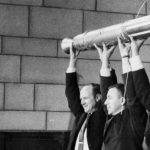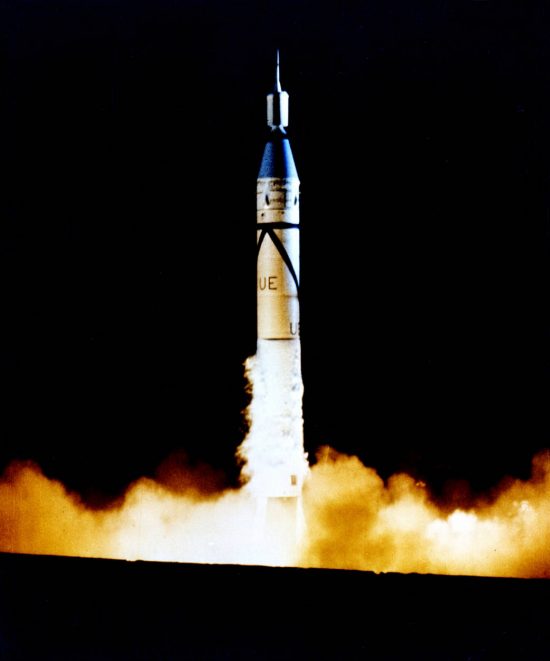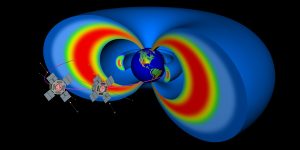

William Picketing, James Van Allen, and German scientist Wernher von Braun (from L to R) hold a model of the first American satellite Explorer 1. This was was taken after the successful launch of the satellite on January 31, 1958 by a ‘Jupiter C’ rocket at Cape Canaveral, Florida. Image via NASA Explorer 1 Gallery.
January 31, 1958. This is the 60th anniversary of the launch of Explorer 1, the first U.S. satellite. It marks the first step into space by the United States. NASA is supporting events in Florida, California, and Washington, D.C., to mark the 60th anniversary of the launch.
Click for more about NASA events celebrating 60 years in space.
Explorer 1 was tiny. It weighed just 30 pounds ( 14 kilograms) and was just under 7 feet long (203 cm). It took 114.8 minutes to complete one orbit of Earth, and therefore completed 12.54 orbits a day. Explorer 1 was also the first satellite to carry a scientific experiment: a cosmic ray detector designed to take measurements of radiation in the space near Earth. Explorer 1’s data led to Van Allen’s hypothesis, later confirmed to be true, of the Van Allen radiation belts.
Russia had launched Sputnik 1, the world’s first artificial satellite, on October 4, 1957. Explorer 1 was launched in quick response by the U.S. It was designed and built in under three months at the Jet Propulsion Laboratory (JPL) by William Hayward Pickering. Pickering was JPL’s director for 22 years until his retirement in 1976. He and his group built and operated the satellite.
Its impact was enormous and helped spur on what was to become an all-out space race.
A new NASA website is available to provide the public with historical information about Explorer 1. The site contains archival imagery and an interactive timeline of American space science firsts:
High-resolution imagery and interviews related to the Explorer 1 launch and America’s six decades of space science missions are available for download at:
https://explorer1.jpl.nasa.gov/media

Through the combined efforts of JPL and the Army Ballistic Missile Ballistic Agency, Explorer 1 launched from Cape Canaveral, Florida, on January 31, 1958. There was a nail-biting wait before tracking stations confirmed that Explorer 1 had gone successfully into orbit around Earth. With the launch of Explorer 1, the United States officially entered the space age. Image and caption via NASA.
Explorer 1 was launched with a Jupiter C rocket provided by the U.S Army Ballistic Missile Agency under the guidance of renowned rocket scientist Wernher von Braun. He worked for the Nazis during World War II, but afterwards began working for the United States. He also worked on the Apollo program by designing Saturn V, the gargantuan rocket that ultimately sent people to the moon.
The science experiment on the rocket was a cosmic ray detector, built by James Van Allen from the University of Iowa. The detector measured levels of radiation much lower than predicted. In response, Van Allen speculated that the detector was malfunctioning because of very strong radiation from charged particles trapped in the Earth’s magnetic field. This idea has been considered a long time ago by other scientists such as Kristian Birkeland and Carl Stoermer.
Another satellite, Explorer 3, sent up only two months later (after Explorer 2 failed), brought back tapes with more evidence to support Van Allen’s speculation. Explorer 4 and other probes were subsequently launched with the sole purpose of mapping what is now called the Van Allen radiation belts. In 1958, two main radiation belts were discovered. A third radiation belt was discovered by the Van Allen Probes in late 2012.
We now know that radiation belts are quite common: other planets in our solar system, Jupiter, Saturn and Uranus for example, also have radiation belts similar to Earth’s. Generally speaking, space radiation poses a risk both to astronauts and to spacecraft.
Click to hear from NASA why space radiation won’t stop human space exploration.

Van Allen radiation belts via NASA.
Explorer 1 orbited Earth for some months. It sent back its last data on May 23, 1958 and was cremated by Earth’s atmosphere on March 31, 1970. It made over 58,000 orbits of Earth in its lifetime.
Bottom line: The U.S. launched Explorer 1 on January 31, 1958. It was the first U.S. step into space and helped fuel the space race with Russia. It also led to the discovery of the Van Allen radiation belts, bands of charged particles trapped in the Earth’s magnetic field.
from EarthSky http://ift.tt/2kc84NZ


William Picketing, James Van Allen, and German scientist Wernher von Braun (from L to R) hold a model of the first American satellite Explorer 1. This was was taken after the successful launch of the satellite on January 31, 1958 by a ‘Jupiter C’ rocket at Cape Canaveral, Florida. Image via NASA Explorer 1 Gallery.
January 31, 1958. This is the 60th anniversary of the launch of Explorer 1, the first U.S. satellite. It marks the first step into space by the United States. NASA is supporting events in Florida, California, and Washington, D.C., to mark the 60th anniversary of the launch.
Click for more about NASA events celebrating 60 years in space.
Explorer 1 was tiny. It weighed just 30 pounds ( 14 kilograms) and was just under 7 feet long (203 cm). It took 114.8 minutes to complete one orbit of Earth, and therefore completed 12.54 orbits a day. Explorer 1 was also the first satellite to carry a scientific experiment: a cosmic ray detector designed to take measurements of radiation in the space near Earth. Explorer 1’s data led to Van Allen’s hypothesis, later confirmed to be true, of the Van Allen radiation belts.
Russia had launched Sputnik 1, the world’s first artificial satellite, on October 4, 1957. Explorer 1 was launched in quick response by the U.S. It was designed and built in under three months at the Jet Propulsion Laboratory (JPL) by William Hayward Pickering. Pickering was JPL’s director for 22 years until his retirement in 1976. He and his group built and operated the satellite.
Its impact was enormous and helped spur on what was to become an all-out space race.
A new NASA website is available to provide the public with historical information about Explorer 1. The site contains archival imagery and an interactive timeline of American space science firsts:
High-resolution imagery and interviews related to the Explorer 1 launch and America’s six decades of space science missions are available for download at:
https://explorer1.jpl.nasa.gov/media

Through the combined efforts of JPL and the Army Ballistic Missile Ballistic Agency, Explorer 1 launched from Cape Canaveral, Florida, on January 31, 1958. There was a nail-biting wait before tracking stations confirmed that Explorer 1 had gone successfully into orbit around Earth. With the launch of Explorer 1, the United States officially entered the space age. Image and caption via NASA.
Explorer 1 was launched with a Jupiter C rocket provided by the U.S Army Ballistic Missile Agency under the guidance of renowned rocket scientist Wernher von Braun. He worked for the Nazis during World War II, but afterwards began working for the United States. He also worked on the Apollo program by designing Saturn V, the gargantuan rocket that ultimately sent people to the moon.
The science experiment on the rocket was a cosmic ray detector, built by James Van Allen from the University of Iowa. The detector measured levels of radiation much lower than predicted. In response, Van Allen speculated that the detector was malfunctioning because of very strong radiation from charged particles trapped in the Earth’s magnetic field. This idea has been considered a long time ago by other scientists such as Kristian Birkeland and Carl Stoermer.
Another satellite, Explorer 3, sent up only two months later (after Explorer 2 failed), brought back tapes with more evidence to support Van Allen’s speculation. Explorer 4 and other probes were subsequently launched with the sole purpose of mapping what is now called the Van Allen radiation belts. In 1958, two main radiation belts were discovered. A third radiation belt was discovered by the Van Allen Probes in late 2012.
We now know that radiation belts are quite common: other planets in our solar system, Jupiter, Saturn and Uranus for example, also have radiation belts similar to Earth’s. Generally speaking, space radiation poses a risk both to astronauts and to spacecraft.
Click to hear from NASA why space radiation won’t stop human space exploration.

Van Allen radiation belts via NASA.
Explorer 1 orbited Earth for some months. It sent back its last data on May 23, 1958 and was cremated by Earth’s atmosphere on March 31, 1970. It made over 58,000 orbits of Earth in its lifetime.
Bottom line: The U.S. launched Explorer 1 on January 31, 1958. It was the first U.S. step into space and helped fuel the space race with Russia. It also led to the discovery of the Van Allen radiation belts, bands of charged particles trapped in the Earth’s magnetic field.
from EarthSky http://ift.tt/2kc84NZ

Aucun commentaire:
Enregistrer un commentaire